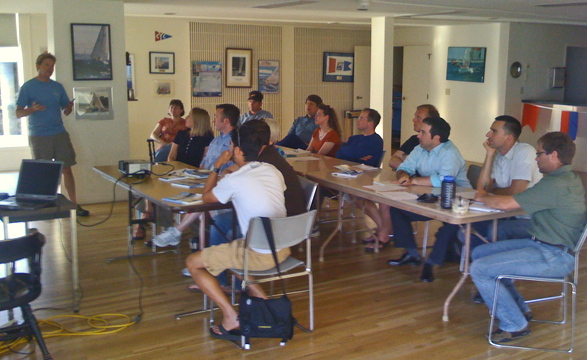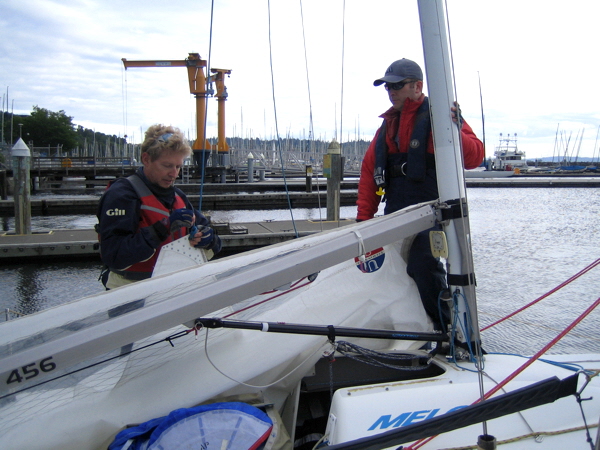
CYC Home
June 2009
By Bruce Van Deventer,
2009 Rookie Rally Coordinator.
Despite the economic downturn, this year's Rookie Rally was one of the best attended in recent years, with 14 sailors coming out to learn about sailboat racing and improve their skills.
Originally an on-the-water weekend regatta, the rookie rally has evolved into a four week series of classroom sessions followed by on-the-water practice, tailored for skippers and crew new to racing or desiring to improve their skills. These are offered free of charge to the community at large, as a means to build the basis of our sport, in alignment with the charter of Corinthian Yacht Club as an amateur sailing organization.

Photo by Bruce Sherman
Bruce Van Deventer, left, outlines the basics of sailboat racing for his students at the first session of this year's Rookie Rally, sponsored by CYC.
The first week started with a slide show providing an introduction to all types of sailboat racing for all types of sailors. This was followed by a discussion of how sailboat racing is organized including clubs, community sailing organizations, regional organizations (such as PHRF), national organization (US Sailing), and international (ISAF). Sailing is unique in the means used to start and finish races, so we devoted part of the first week and second week to the rules defining how we start, how we use signals to communicate, and so forth.
The next week covered the core rules in Part 2 (When Boats Meet) of the Racing Rules of Sailing, and we discussed basic tactics for starting and sailing the weather leg. The next week covered rule 18 (At Marks and Obstructions) and wrapped up the remainder of the rules and strategy discussion.
We then put these rules into practice with our parking lot regatta. In this regatta, the rookies each prepare a cardboard or wood cutout sailboat, with a pivoting boom to indicate which tack the boat is on. We all then go out into the parking lot, and set up a mock race course using some bricks to represent the start/finish line and the marks. The rookies are then given a starting sequence and they walk their boats through an entire race.

Photo by Susan Weiss
Van Deventer, left, shows a rookie how to attach the halyard to the head of the mainsail on the Melges 24 Wiggle Room.
We find people have a better perspective when they put the boats in their relative positions on the parking lot and look left or right over their shoulder at the other boats, a perspective they don't get with diagrams in book or on a chalk board. We can also freeze the action at any time during a race and then have a group discussion about what rules apply. We can also set up particular situations and discuss the tactical advantage to each boat.
Finally we completed the rally by bringing groups of four sailors out on the Melges 24 "Wiggle Room." The Melges has a simple rig that's flexible, and thus it is great for showing the effect on the sails of major controls such as the backstay, mainsheet/traveler combo, and vang. The students got the chance to work each control, while driving, to get a better feel for what they did, and we made a series of tacks to get the feel for what you're supposed to do with the hiking stick and mainsheet while you tack.
A student who was more dinghy-oriented came out on my 505, and we reviewed the same core concepts in a higher performance dinghy; we had enough wind to get him out on the wire with the spinnaker, which was great. We also had one nice day with enough wind to get the Melges up on a plane, which was cool because some of our rookies said that this was the fastest they'd ever been on a sailboat.
I was very pleased overall with the level of interest and excitement of the students, and I think it bodes well for the future of our sport.